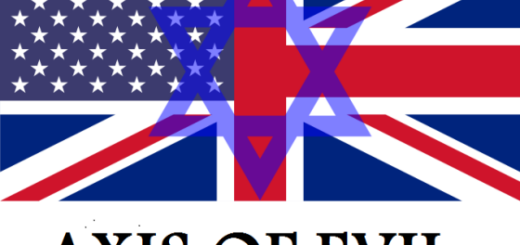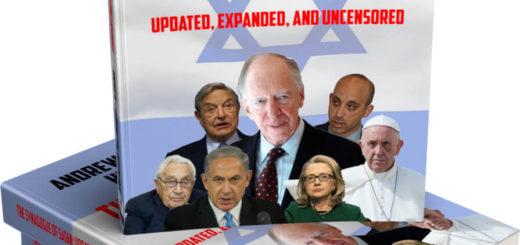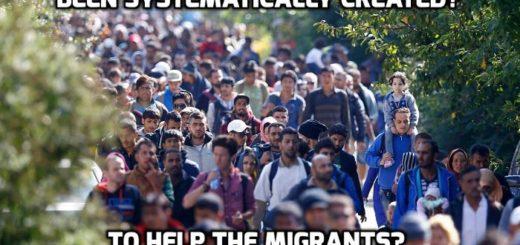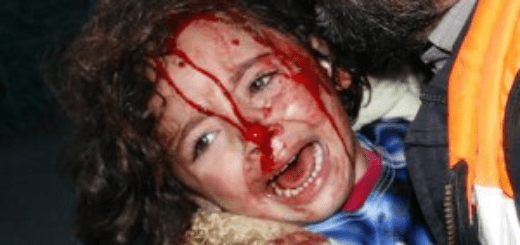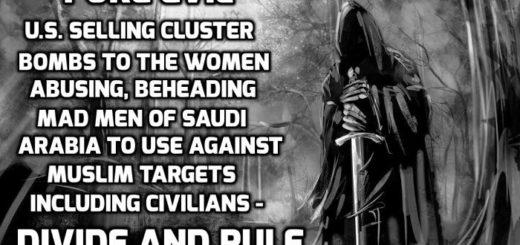How 9/11 Was Engineered: The British Monarchy & Saudi Arabia (Connected to H.W. Bush)
This article appears in the May 23, 2014 issue of Executive Intelligence Review.
CHARLES OF ARABIA:
The British Monarchy,
Saudi Arabia, and 9/11
by Richard Freeman and William F. Wertz, Jr.
May 15—In a webcast on Oct. 26, 2012, Lyndon LaRouche emphasized that the Saudi Kingdom and the British Empire are one and the same institution—one extended British Empire. This is emphatically also the case when it comes to terrorism, and specifically to 9/11. As EIR has documented, the black ops slush fund employed by the Saudis, and in particular, by Prince Bandar bin Sultan, in supporting al-Qaeda, was derived from the arms deal, known as Al-Yamamah, beginning in 1985, between the British company BAE and the Saudi Ministry of Defense and Aviation.
However, there are two aspects of the 9/11 attack which have not been adequately exposed to the public to date. First, the direct relationship between the British Royal Family and the Saudi Royal Household; and second, the top-down interface between a consortium of Saudi banks and charitable organizations which have been identified as the financial-logistical infrastructure of the al-Qaeda terrorist network (see below).
These two additional features will be presented in two parts, beginning with this article documenting the close relationship of Prince Charles, as the designated representative of the British Royal Family, to the current Saudi Monarchy.
A Pending Day in Court
During the course of last year, two U.S. Federal Court decisions cleared the way for the 9/11 families to pursue court cases against the perpetrators of the attacks. On April 16, 2013, a decision was rendered that reinstated the case against 12 Saudi individuals, 9 of whom are Saudi charity officials who held top positions in Saudi institutions, and who are alleged by the plaintiffs to have taken concrete actions to assist in the 9/11 attacks.
Then, on Dec. 19, 2013, a Federal Court decision allowed the plaintiffs to pursue the case against the Kingdom of Saudi Arabia itself and the Saudi High Commission for Relief of Bosnia and Herzegovina.
In April 2014, a Federal judge in Florida ordered the FBI to provide plaintiffs in a Freedom of Information Act suit with documents on a Saudi cell in Sarasota, which is believed to have provided support to several of the 9/11 terrorists, including the ostensible ringleader Mohammed Atta.
In the U.S. Congress, a resolution (Resolution 428) has been introduced with bipartisan support insisting that a 28-page chapter of the Joint Congressional Inquiry on 9/11, which discusses Saudi Arabian financial support for the terrorists, be declassified.
The picture presented in this, and a subsequent article, is meant to encourage this investigation, and to give it a dimension which it has thus far lacked.
Prince Charles
Contrary to popular opinion, the British Empire does still exist. In many respects, it is more global, more powerful, and more vicious than during its heyday in the 18th and 19th centuries. Moreover, the Kingdom of Saudi Arabia, which was effectively created by the British Empire between 1901 and 1932, is a critical extension of that Empire. Abdulaziz ibn Saud, who became Saudi monarch in 1932, was on the British payroll for more than a decade. For the last three decades, the member of the British Royal Family who has been Empress Elizabeth II’s chief executive officer, working directly with the Saudi royal household, and with the key Saudi personalities implicated in creating al-Qaeda and in supporting 9/11, has been Prince Charles. Among Charles’s closest collaborators are:
Prince Bandar bin Sultan bin Abdulaziz al Saud (married to Princess Haifa, who is the sister of Prince Turki bin Faisal and Prince Mohammed bin Faisal), Saudi Ambassador to the U.S., 1983-2005; Secretary-General of the Saudi National Security Council, 2005 to the present; and head of Saudi Intelligence from July 2012 until recently;
Prince Turki bin Faisal bin Abdulaziz al Saud, Director-General of Saudi Intelligence, 1979-2001; Saudi Ambassador to the U.K., 2003-05; Saudi Ambassador to the U.S., 2005-06;
Prince Mohammed bin Faisal bin Abdulaziz al Saud (brother of Prince Turki and of Princess Haifa), head of the Dar Al-Maal Al-Islami Trust (DMI) banking group, which has been linked to al-Qaeda financing, according to a report prepared in 2002 for the preisdent of the UN Security Council by Jean-Charles Brisard.
Prince Charles has been placed by the Queen at the head of British-Saudi Empire terror machine, utilizing relationships he has developed over more than a quarter of a century, at least since his first state visit to Saudi Arabia in 1986.
The Prince, born in 1948, invested with numerous noble titles (Prince of Wales, Duke of Cornwall, Duke of Rothesay, Earl of Carrick, etc.), and a family estate worth many billions, has handled some of the filthiest assignments for the Anglo-Dutch Empire. Charles has been protected by his carefully constructed public image as a plant-loving environmentalist—he talks to them—and as somewhat dotty. But there is a real thug behind that veneer:
Charles plays a leading role in arming Saudi Arabia. He was pivotal during the 1990s in concluding contracts for Al-Yamamah II, the second phase of the BAE-British arms-for-Saudi-oil deal, originally contracted in 1985 by Prince Bandar which, as EIR has documented, set up a slush fund to finance international terror. During his tenth state visit to Saudi Arabia on Feb 17-19, 2014—he has also undertaken many private visits—Charles finalized the massive Al-Salam arms deal, by which British defense firm BAE Systems is selling 72 Eurofighter Typhoons to Saudi Arabia.
In 2012, Charles became the first royal patron of all three main British intelligence services: the Secret Intelligence Service (MI6), Security Service (MI5), and Communications Headquarters (GCHQ-Cheltenham).
Charles is at the forefront of Queen Elizabeth’s drive, through starvation, disease, war, and murder, to reduce the world’s population from its present 7 billion persons to 1 billion. According to Charles’ semi-official biography, The Prince of Wales by Jonathan Dimbleby, the Prince held a two-day international seminar, on board the royal yacht Britannia, which set the agenda for the 1992 Rio Earth Summit. The summit launched the Intergovernmental Panel on Climate Change (IPCC)’s campaign promoting the genocidal hoax of anthropomorphic global warming, as the vehicle to shut down industry and civilization.
On Charles’ website (http://www.princeofwales.gov.uk/), he promotes Paul Ehrlich’s 1968 book, The Population Bomb, which called for slashing the world’s population to 1.5 billion.
According to the book Saudi Babylon, by Mark Hollingsworth, there was a meeting in April 2003 at the headquarters of New Scotland Yard, between top British anti-terrorism officials, and lawyers for the families of the victims of the 9/11 massacre. The lawyers and families were pressing for Britain’s official agencies to investigate claims of Saudi financing of international terrorism. A member of the British Special Branch forces told Hollingsworth that Prince Charles’ “relationships with prominent members of the House of Saud created serious problems and obstacles” to that investigation.
The Cranwell Connection
Another critical aspect of Charles’ background, particularly in respect to his relationship with Prince Bandar, that both are graduates of RAF Cranwell, the elite training school for British Royal Air Force officers. Senior U.S. intelligence officials deeply involved in the ongoing investigation into the 9/11 attacks and the deeper issue of the Anglo-Saudi Al-Yamamah project believe that Bandar was recruited as a British intelligence asset during his training at Cranwell.
In March 1967, Bandar enrolled at Cranwell; Charles enrolled March 8, 1971. William Simpson, in his biography of Prince Bandar, The Prince: The Secret Story of the World’s Most Intriguing Royal, Prince Bandar bin Sultan, describes Bandar’s two-and-a-half year immersion at Cranwell as a formative period in his life, during which time he became a dedicated anglophile. Although the two princes attended at different times, shared an instructor, Sir Richard Johns, and their common experience at RAF Cranwell as pilots was a critical aspect of their later close relationship. Two other members of the Faisal clan were classmates of Bandar at Cranwell: a brother of Princess Haifa; and Prince Muqrin bin Abdulazziz al Saud, head of Saudi Intelligence from 2005-12, who has now been designated the second crown prince of Saudi Arabia.
The relationship among Charles, Bandar, Princess Haifa’s brother, and Muqrin, as RAF-trained pilots, may not be insignificant in respect to 9/11. Bandar’s brother Prince Khalid bin Sultan was also commander of the Saudi Air Force during the first Gulf War. Also note the role of the Saudi aviation company Dallah Avco in supporting the 9/11 operation.
Simpson further writes: “In December 1972, Bandar married Princess Haifa, daughter of Saudi Arabia’s ruler, King Faisal. In recalling how they met, Haifa explained, ‘Bandar was with my brother at RAF Cranwell. My brother had talked about him to me, and about me to him; this was in 1966. From that time on, for some reason or other I had a feeling that this was the man I was going to marry.’ “
As to the relationship between Charles and Bandar, Simpson reports: “While Bandar has enjoyed firm friendship with many world leaders, he holds Baroness Margaret Thatcher in particularly high esteem. Equally, his friendship with Prince Charles is also very close, and Charles extended a personal invitation to Bandar to his wedding to Camilla Parker Bowles in April 2005. [Charles invited only eight foreign royals, among them, Prince Turki and his wife, and Prince Bandar bin Sultan—ed.]. The Princes’ friendship can be traced back to their experiences of Cranwell (Charles was also training at Cranwell) and Charles’s fascination with Islam.”
Charles’ biographer Dimbleby writes: “Squadron leader Richard Johns, later Air Marshall, was the Prince’s instructor from September 1970 to August 1971. During the 1990-91 war on Iraq (Operation Desert Storm) Johns, by then Vice Air Marshall, was one of three directors of the British war command.”
According to Simpson, Bandar was the most important person in the Saudi Kingdom coordinating the war effort. Furthermore, Bandar’s brother, Prince Khalid bin Sultan, the commander of the Saudi Air Force, was made Commander of the Joint Forces, which meant he shared equal rank and responsibility with U.S. Gen. Norman Schwartzkopf, and the commander of British troops during the war. As a result, Bandar and his brother Khalid worked directly with Johns during this period, consolidating their relationship. After the first Gulf War, Johns was promoted to Air Marshall in 1993; made chief of the Air Staff in 1997; that same year, he was appointed Air Aide-de-Camp to Queen Elizabeth; and in 2000, upon retiring as Chief of the Air Staff, Johns was appointed Constable and Governor of Windsor Castle, where he resided from 2000-08. The latter position put him at the right hand of Queen Elizabeth, with whom he met and/or consulted regularly.
The picture which now emerges is that of the close relationship between the top echelon of the Faisal clan and the House of Windsor, involving British intelligence and Saudi intelligence, and the British and Saudi Royal Air Forces, mediated by Prince Charles and Prince Bandar, in particular.
The Anglo-Saudi 9/11 Nexus
Now we shall look more closely at the collaboration between Prince Charles and the Saudi Royal family suspected of orchestrating 9/11. One of the organizations which Prince Charles operates is the Oxford Centre for Islamic Studies (OCIS), created at Magdalen College, Oxford University, in 1985. According to the May 10, 2012 Oxford Times, Charles has been an enthusiastic supporter of the Centre since its founding.
In 1993, Charles became the patron of the OCIS and effectively took it over. It is referred to in the press at times as Charles’ OCIS.
One of the co-founders of the OCIS is Abdullah Omar Naseef, who is named in the court case brought by the families of the victims of 9/11 for his role in supporting the hijackers. He also founded and chaired the Rabita Trust, and served as Secretary General of the Muslim World League (MWL), 1983-93, during the height of Anglo-American backing for the Afghan mujahideen in their war against the Soviet Union. The MWL was founded in the 1960s, when leading figures in the Egyptian Muslim Brotherhood took refuge in Saudi Arabia, after the Nasser regime crackdown. The international revolutionary mission of the Muslim Brotherhood was merged with the Wahhabi branch of Islam to form the basis for a global jihadist recruitment drive. The MWL was at the very center of the formation of the global jihad apparatus that is at the heart of global terrorism to this day.
In the early 1980s, Naseef co-created the Maktab al-Khidamat, which was the backbone organization of the Arab-Afghani mujahideen in Afghanistan, which in 1989, changed its name to al-Qaeda, and, according to the 9/11 families’ suit, knowingly provided financial support to al-Qaeda through the MWL, Rabita, and the International Islamic Relief Organization (IIRO).
Naseef currently chairs the Board of Trustees of Prince Charles’ OCIS, and has been the Prince’s confidant for two decades.
Abul-Hasan Ali al-Nadwi was another co-founder of the OCIS and its chairman from its inception in 1985, through the late 1990s—during which time Charles was its patron. In 1962, Nadwi was a founding board member of the MWL.
Another member of the Board of Trustees of Charles’ OCIS from 1985 until 2006, was Yusuf al-Qaradawi, the Qatar-based spiritual leader of the Muslim Brotherhood. It was Qaradawi who issued the fatwa to overthrow and assassinate Libya’s Muammar Qaddafi and Syria’s Bashir al-Assad. In July 2012, he threatened the assassination of Egyptian leader Gen. Abdel Fattah al-Sisi.
In 1990, Prince Bandar, then Saudi Ambassador to the United States, contributed an estimated $13-$24.4 million to the OCIS; at that time, he was collecting $100 million per year in fees from the Al-Yamamah deal. In 1997, Bandar persuaded then-Saudi King Fahd to make a $32.4 million contribution from the Kingdom to the OCIS. The contribution, according to the May 30, 1997 Financial Times, was made at a private dinner with Prince Charles in England, with Bandar chosen as the person to announce the gift.
Other principally Islamic nations and individuals, including Qatar and Kuwait, contributed approximately $70 million to Charles’ Centre, including funds from the family of Osama bin Laden. Prince Turki is a member of the Board of Trustees of the OCIS and also chairs the OCIS Strategy Advisory Committee.
In May 2012, Queen Elizabeth II herself granted the OCIS a Royal Charter in honor of its 25th anniversary. At the time, Naseef, a man being sued by the families of the victims of 9/11, stated: “This is very good news. This shows that the British government, the Queen, and the whole state are very much aware that the Oxford Centre for Islamic Studies is doing very well to make relations between the Islamic world and the Western world closer and to bring Islam and its role in the international arena.”
The bin Laden family has endowed the Mohammed bin Laden chair at Prince Charles’ OCIS, named after the father of Osama bin Laden.
In addition to the collaboration among Charles, Bandar, and Turki in the OCIS, they also work together in another intelligence front, the Prince Charles Visual Islamic and Traditional Arts Department (VITA). Charles recruited Prince Turki to join VITA, and then appointed him chairman, where he served from the early- to mid-1990s until at least 2006. In 2004, Charles set up the Centennial Fund, whose Chairman of the Board of Trustees is Prince Abdulaziz bin Abdullah; Abdulaziz is Deputy Foreign Minister of Saudi Arabia, and the person in Riyadh tasked to arm and direct Wahhabi terrorists operating in Syria.
Turki, Bandar, al-Qaeda, and 9/11
In 1979, Prince Turki was appointed Director-General of Saudi Arabia’s General Intelligence Directorate. He remained in that position until Sept. 1, 2001, just ten days before 9/11. Turki personally recruited Osama bin Laden to become a jihadi, and to use his large financial resources to set up a network, the Maktab al-Khidamat, which became al-Qaeda.
According to Khudi.pak, a Pakistani website: “Usama Bin Ladin met the head of the Saudi security service, Prince Turki bin Faisal Ibn Abdelaziz in 1978. Bin Laden had begun to associate with Islamic radicals who played on his feelings of inner religious crisis and growing isolation from his family to lead him towards becoming an extremist. He was introduced to local members of the Muslim Brotherhood, who only drove Usama further towards extremism.
“In 1979 Usama Bin Ladin went to Prince Turki for advice after he became infuriated by the Soviet invasion of Afghanistan. Following Prince Turki’s suggestion that Bin Ladin use his financial assets to aid the Afghan resistance, Usama traveled to neighboring Pakistan to wage jihad on the Soviet Union.”
In an interview in 2002, Prince Turki stated, “In 1980, when the Soviets invaded Afghanistan, we in the Kingdom, with the United States, initiated a program of countering the Soviet invasion and helping the Mujahideen to repel the Soviets. I was directly involved in that situation.”
An article in the March 1, 2003 Observer reported that lawyers for 11 relatives of 9/11 victims served legal papers on Prince Turki, which state, according to the Observer: “Based on sworn testimony from a Taliban intelligence chief called Mullah Kakshar, they allege that Turki arranged for donations to be made directly to al-Qaeda and bin Laden by a group of wealthy Saudi businessmen.”
Author Gerald Posner in his book Why America Slept reported that Abu Zubaydah, a leading al-Qaeda operative, was captured by CIA agents on March 28, 2002 at a safe house in Pakistan. CIA agents administered sodium pentothal, and Zubaydah revealed that directions and funds for al-Qaeda came from Saudi Arabia and Saudi Intelligence chief Prince Turki. Zubaydah said that he had been a participant in a 1998 meeting in Khadahar, Afghanistan with Prince Turki, Pakistani ISI intelligence officials, and Taliban leaders, in which Turki promised more Saudi aid would flow to the Taliban. Zubaydah provided the names and phone numbers of the Saudis who transmitted the money and directions from Turki, and the names checked out, according to Posner.
In his book The Big Bamboozle: 9/11 and the War on Terror, author Philip Marshall, a veteran airline pilot, contended that the Saudi 9/11 pilots needed advanced training, beyond what they received on small aircraft, to fly the Boeing jets they hijacked, training which he believes they received with the aid of Prince Turki.
Marshall points out that four of the future hijackers traveled to Las Vegas, and that these four became the pilots of the four planes used on 9/11. He concludes that they must have received training somewhere between Las Vegas and Tucson, Ariz. Marshall then reports that Prince Turki and his entourage were in the United States prior to, and on Sept. 11, 2001. Tucked in the back of the 9/11 Commission’s report (and later deleted) was an account of three separate chartered airliners carrying about 100 Arab men (mostly Saudis) from Las Vegas on overnight trans-Atlantic flights, beginning on Sept. 19.
Marshall elaborates on this report. He says that Turki was near Las Vegas in the months leading up to 9/11, during the time that all the hijackers had made trips there. In the week after the attack, there were at least five chartered flights carrying high-ranking Saudi officials which flew out of Las Vegas, Newark, Boston, and Washington. The chartered departures from Las Vegas the following: a flight to Geneva on Sept. 19, with 69 passengers, including 46 Saudis; one bound for England with 18 Saudis on Sept. 20; and, on Sept. 23, a flight to Paris, on which only 34 passengers were listed, out of a capacity of nearly 400. On that flight was Prince Turki. Marshall makes the point that Turki’s large entourage in the U.S. in the Summer of 2001 provided a perfect opportunity to get the needed Saudi Boeing flight instructors into the country, and out again after the attacks without anyone interviewing them.
While Turki, as head of Saudi Intelligence and Osama bin Laden’s handler, is suspected of playing a commanding role in 9/11, Prince Bandar played the critical role inside the United States itself, as Ambassador from 1983-2005. It was Turki and Prince Sultan (Bandar’s father and Defense Minister), who, in 1978, helped bring Bandar into a position of power in Washington. At that time, they were negotiating Saudi Arabia’s purchase of 50 F-15 fighters from the United States. William Simpson, Bandar’s biographer, writes: “Assisting Prince Turki bin Faisal, Bandar quickly made his mark in Washington. He quickly became very close to the Bush family, to the point of being called Bandar Bush by the Bush family itself.”
In the late 1970s, when George H.W. Bush was head of the CIA, Bandar worked with Turki in support of what later became al-Qaeda in Afghanistan. Then, as the architect of the 1985 Al-Yamamah arms-for-oil barter deal between Britain and Saudi Arabia, Bandar gained control of a huge offshore slush fund for covert operations. During the 1980s, when the U.S. Congress cut off funding for the Contra operation in Nicaragua, it was Prince Bandar who supplied the funding, at the request of then-Vice President George H.W. Bush.
Evidence of Bandar’s involvement in 9/11 is further reinforced by the disclosure that his wife, Princess Haifa, the sister of Prince Turki, passed between $51,000 and $73,000 to Saudi intelligence operative Omar al-Bayoumi, which money in turn was used to help establish the first two 9/11 Saudi hijackers to arrive in the U.S., Nawaf al-Hazmi and Khalid al-Mihdhar, in San Diego, Calif.
Prince Mohammed bin Faisal and Prince Charles
The second article in this two-part series will focus on the Saudi consortium of seven banks run by Prince Mohammed bin Faisal and the associated network of charities that were designed to provide financial and logistical support for al-Qaeda. For the purposes of this first installment, we will merely identify the close relationship of Prince Charles and Prince Mohammed bin Faisal.
In November 2001, Prince Mohammed and Prince Charles headed the committee that raised the money to construct the London Muslim Centre, which was a physical addition to the Muslim Brotherhood-controlled East London Mosque, which has a trust called the East London Mosque Trust. In a history of itself, the Trust wrote: “On the 23rd of November 2001, His Royal Highness, the Prince of Wales and His Royal Highness Prince Mohammed bin Faisal laid the foundation stone of the London Muslim Centre as part of a ceremony to launch the construction project.”
The mosque is known to be a center of Wahhabism and of the Islamist group Jamaat-e-Islami (JI). The U.K. Department of Communities and Local Government released a statement on Feb. 28, 2013 saying that the current Secretary General of the Muslim Council of Britain is the chair of the East London Mosque, the key institution for the Bangladeshi wing JI in the U.K.
The collaboration between Princes Charles and Mohammed includes the fact that Yusuf al-Qaradawi was a member of the Board of Trustees of Charles’ Oxford Centre for Islamic Studies at the same time that he was an executive of some of Mohammed bin Faisal’s banks. Specifically, Qaradawi served as the “Sharia advisor” of the DMI banking group, from about the time of its founding in 1981 until 1994. During this same time period, Qaradawi was also a founder and principal stockholder of the al-Taqwa Bank, and served as the al-Taqwa Bank’s Sharia advisor. Thus, Qaradawi was a shared asset of Prince Charles and Prince Mohammed.
Mohammed Galeb Kalje Zouaydi, according to Agence France Presse on Sept. 20, 2002, was the accountant for the Faisal branch of the Saudi Royal Family, including Prince Mohammed bin Faisal and Prince Turki bin Faisal. According to French investigator Jean-Charles Brisard, Zouaydi was considered to be one of the major funders of the al-Qaeda network in Europe. On April 23, 2002, authorities in Spain arrested and charged Zouaydi, whom they alleged was a key al-Qaeda financier.
The May 6, 2002 Chicago Tribune reported that according to Spanish authorities, financier Zouaydi had ties to the cell in Germany that carried out the Sept. 11 attacks. In short, Prince Mohammed and Prince Turki’s accountant, Zouaydi, was funneling money to al-Qaeda around the world.
Finally, there is the connection between Prince Mohammed bin Faisal and Saleh Abdullah Kamel the founder of the Dallah al-Baraka banking group. In his book, Preachers of Hate: Islam and the War on America, Kenneth Timmerman provides a capsule profile of Kamel: “Born in Mecca in 1941, Sheik Saleh Abdallah Kamel became an adviser to the Saudi Ministry of Finance and a business partner of Prince Mohammed bin Faisal bin Abdulaziz, son of former King Faisal.”
Dallah Avco, the Saudi aviation company, is a subsidiary of Kamel’s Dallah al-Baraka bank. Dallah Avco is being sued by the families of the victims of 9/11. According to the suit, the company provided a “ghost job” to Saudi Intelligence operative Omar al-Bayoumi. Moreover, plaintiffs assert that Dallah Avco was aware of Bayoumi’s activities in the United States, as illustrated by the fact that senior officials of Dallah Avco quickly squelched internal inquiries from Bayoumi’s immediate supervisor concerning the nature and propriety of his employment with the company. The Saudi Ministry of Defense and Aviation threatened to cut off contracts to Dallah if they dismissed Bayoumi.
Bayoumi received a monthly payment of up to $3,000 from Kamel’s Dallah Avco as payment for a project in Saudi Arabia, even though Bayoumi was living in San Diego. At the time of the payments, Bayoumi and another Saudi, Osama Basnan, were bankrolling the two lead 9/11 hijackers with the Dallah funds, and the direct payments from Prince Bandar and Princess Haifa.
The 28-page chapter from the Joint Congressional Inquiry into 9/11—which Presidents George W. Bush and Barack Obama have suppressed to this day—contain a detailed account of both the Bandar and Dallah Aviation bankrolling of the San Diego al-Qaeda cell, according to former Sen. Bob Graham (D-Fla.), who chaired the Joint Inquiry, and wrote about the experience in his 2004 book Intelligence Matters.



